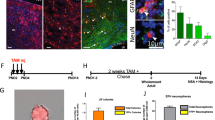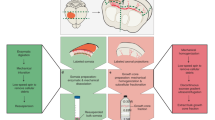Abstract
Neuronal precursor cells are widespread in the forebrain ventricular/subventricular zone, and may provide a cellular substrate for brain repair. Clonal lines derived from single progenitors can become progressively less representative of their parental precursors with time and passage in vitro. We have developed an alternative strategy for the isolation and enrichment of precursor cells, by fluorescence-activated cell sorting of forebrain cells transfected with the gene for green fluorescent protein, driven by the neuronal Tα1 tubulin promoter. Using this approach, neural precursors and young neurons can be identified and selectively harvested from a variety of samples, including both avian and mammalian forebrains at different developmental stages.
This is a preview of subscription content, access via your institution
Access options
Subscribe to this journal
Receive 12 print issues and online access
$209.00 per year
only $17.42 per issue
Buy this article
- Purchase on Springer Link
- Instant access to full article PDF
Prices may be subject to local taxes which are calculated during checkout
Similar content being viewed by others
References
Goldman, S.A. 1995. Neuronal precursor cells and neurogenesis in the adult fore-brain. The Neuroscientist 1:338–350.
Goldman, S.A. 1997. Comparative strategies of subependymal neurogenesis in the adult forebrain. in Isolation, characterization and utilization ofCNS stem cells. 43–65 Springer-Verlag, Berlin.
Weiss, S., Reynolds, B.A., Vescovi, A.L., Morshead, C., Craig, C.G., and van der Kooy, D. 1996. Is there a neural stem cell in the mammalian forebrain? Trends Neurosci. 19:387–393.
Goldman, S.A. and Nottebohm, F. 1983. Neuronal production, migration, and differentiation in a vocal control nucleus of the adult female canary brain. Proc. Natl. Acad. Sci. USA 80:2390–2394.
Goldman, S.A. 1990. Neuronal development and migration in explant cultures of the adult canary forebrain. J. Neurosci. 10:2931–2939.
Lois, C. and Alvarez-Buylla, A. 1993. Proliferating subventricular zone cells in the adult mammalian forebrain can differentiate into neurons and glia. Proc. Natl. Acad. Sci. USA 90:2074–2077.
Luskin, M.B. 1993. Restricted proliferation and migration of postnatally generated neurons derived from the forebrain subventricular zone. Neuron 11:173–189.
Kirschenbaum, B., Nedergaard, M., Preuss, A., Barami, K., Fraser, R.A., and Goldman, S.A. 1994. In vitro neuronal production and differentiation by precursor cells derived from the adult human forebrain. Cerebral Cortex 4:576–589.
Kirschenbaum, B. and Goldman, S.A. 1995. Brain-derived neurotrophic factor promotes the survival of neurons arising from the adult rat forebrain subependymal zone. Proc. Natl. Acad. Sci. USA 92:210–214.
Morshead, C.M., Reynolds, B.A., Craig, C.G., McBurney, M.W., Staines, W.A., Morassutti, D., et al. 1994. Neural stem cells in the adult mammalian forebrain: a relatively quiescent subpopulation of subependymal cells. Neuron 13:–1082.
Luskin, M., Zigova, T., Soteres, B., and Stewart, R. 1997. Neuronal progenitor cells derived from the anterior subventricular zone of the neonatal rat forebrain continue to proliferate in vitro and express neuronal phenotype. Mol. Cell. Neurosci. 8:351–366.
Pincus, D.W., Harrison, C., Goodman, R.R., Edgar, M., Keyoung, H., Fraser, R.A.R., et al. 1997. FGF2/BDNF-responsive neuronal progenitor cells in the adult human subependyma. Ann. Neurol. In press.
Palmer, T.D., Ray, J., and Gage, F.H. 1995. FGF-2-responsive neuronal progenitors reside in proliferative and quiescent regions of the adult rodent brain. Mol. Cell Neurosci. 6:474–486.
Richards, L.J., Kilpatrick, T.J., and Bartlett, P.F. 1992. De novo generation of neuronal cells from the adult mouse brain. Proc. Natl. Acad. Sci. USA 89:8591–8595.
Reynolds, B.A. and Weiss, S. 1992. Generation of neurons and astrocytes from isolated cells of the adult mammalian central nervous system. Science 255:1707–1710.
Gritti, A., Parati, E.A., Cova, L, Frolichsthal, R, Galli, R., Wanke, E., et al. 1996. Multipotential stem cells from the adult mouse brain proliferate and self-renew in response to basic fibroblast growth factor. J. Neurosci. 16:1091–1100.
Vescovi, A.L, Reynolds, B.A., Fraser, D.D., and Weiss, S. 1993. BFGF regulates the proliferative fate of unipotent (neuronal) and bipotent (neuronal/astroglial) EGF-generated CNS progenitor cells. Neuron 11:951–966.
Johe, K.K., Hazel, T.G., Muller, T., Dugich-Djordjevic, M.M., and McKay, R.D. 1996. Single factors direct the differentiation of stem cells from the fetal and adult central nervous system. Genes Dev. 10:3129–3140.
Goldman, S.A., Zukhar, A., Barami, K., Mikawa, T., and Niedzwiecki, D. 1996. Ependymal/subependymal cells of the postnatal and adult songbird brain generate both neurons and non-neuronal siblings, in vitro and in vivo. J. Neurobiol. 30:505–520.
Goldman, S., Kirschenbaum, B., and Harrison, C. 1997. Neuronal precursor cells of the adult rat ventricular zone persist into senescence, with no change in spatial extent or BDNF response. J. Neurobiol. 32:554–566.
Goldman, S.A. and Nedergaard, M. 1992. Newly generated neurons of the adult songbird brain become functionally active in long-term culture. Dev. BrainResearch 68:217–223.
Weiss, S., Dunne, C., Hfwson, J., Wohl, C., Wheatley, M., Peterson, A.C., and Reynolds, B.A. 1996. Mpipotent CNS stem cells are present in the adult mammalian spinal cord and v|ntricular neuroaxis. J. Neurosci. 16:7599–7609.
Morshead, C. and van d|r Kooy, D. 1992. Postmitotic death is the fate of consti-tutively proliferating cell in the subependymal layer of the adult mouse brain. J. Neurosci. 12:249–256.
Miller, R, Naus, C., Dura^KJ, M., Bloom, F,. and Milner, R. 1987. Isotypes of a-tubu-lin are differentially regulated during neuronal maturation. J. Cell Biol. 105:3065–3073.
Miller, R, Tetzlaff, W., Biifey, M., Fawcett, J., and Milner, R. 1989. Rapid induction of the major embryonic JHubulin mRNA, Ta1, during nerve regeneration in adult rats. J. Neurosci. 9:1452–l463.
Gloster, A., Wu, W., ], A., Weiss, S., Causing, C., Pozniaj, C., et al. 1994. The Ta1 a-tubulin prom||er specifies gene expression as a function of neuronal growth and regeneration transgenic mice. J. Neurosci. 14:7319–7330.
Chalfie, M., Tu, Y, Euskilfehen, G., Ward, W., and Prasher, D. 1994. Green fluorescent protein as a markeif for gene expression. Science 263:802–805.
Heim, R. and Tsien, R. 1906. Engineering green fluorescence protein for improved brightness, longer wavejlngths and energy transfer. Current Biol. 6:178–183.
Levy, J., Muldoon, R., S>lotukhin, S., and Link, C. 1996. Retroviral transfer and expression of a humanized, red–shifted green fluorescent protein gene into human tumor cells. Bio/Technology 14:610–614.
Bailey, K., Drago, J., andSartlett, P. 1994. Neuronal progenitors identified by their inability to express class 1 histocompatibility antigens in response to interferon-g. J. Neurosci. Res. 39:166–177.
Vaysse, P. and Goldman, J. 1990. A clonal analysis of glia lineages in neonatal forebrain development in vitro. Neuron 5:227–235.
Szabo, A., Dalmau, J., Hanley, G., Rosenfeld, M., Posner, J., and Furneaux, H. 1991. HuD, a paraneoplfiistic encephalomyelitis antigen, contains RNA binding domains and is homologous to elav and sex-lethal. Cell 67:325–333.
Marusich, M. and Westoh, J. 1992. Identification of early neurogenic cells in the neural crest lineage. De^Biol. 149:295–306.
Barami, K., Iversen, K., iurneaux, H., and Goldman, S.A. 1995. Hu protein as an early marker of neuronal phenotypic differentiation by subependymal zone cells of the adult songbird forebrain. J. Neurobiol. 28:82–101.
Lee, M., Rebhun, L., and Frankfurter, A. 1990. Posttranslational modification of class III β-tubulin. Proc. Natl. Acad. Sci. USA 87:7195–7199.
Menezes, J.R. and Luskin, M.B. 1994. Expression of neuron-specific tubulin defines a novel population in the proliferative layers of the developing telen-cephalon. J. Neurosci. 11:5399–5416.
Lemmon, V. 1985. Monoclonal antibodies specific for glia in the chick central nervous system. Dev. Brain Research 23:111–120.
Goldman, S.A., Lemmon, V., and Chin, S.S. 1993. Migration of newly generated neurons upon ependymally derived radial guide cells in explant cultures of the adult songbird forebrain. Glia 8:150–160.
Frederiksen, K. and McH|iy, R.D. 1988. Proliferation and differentiation of rat neu-roepithelial precursor eels in vivo. J. Neurosci. 8:1144–1151.
Clark, S., Shetty, A., BraSHey, J. and Turner, D. 1994. Reactive astrocytes express the embryonic intermediate neurofilament nestin. NeuroReport. 5:1885–1888.
Bansal, R., Lemmon, V, Gard, A., Ranscht, B., and Pfeiffer, S. 1989. Multiple and novel specificities of monoclonal antibodies O1, O4, and R-Mab, in the analysis of oligodendrocyte development. J. Neurosci. Res. 24:548–557.
McCoy, J.P., Chambers, W., Lakomy, R., Campbell, J., and Stewart, C. 1991. Sorting minor subpopuliftions of cells: Use of fluorescence as the triggering signal. Cytometry 12:268–274.
Nedergaard, M., Goldrrtim, S., Desai, S., and Pulsinelli, W. 1991. Acid-induced death in neurons and glto. J. Neurosci. 11:2489–2497.
Goldman, S.A., Zarembii, A., and Niedzwiecki, D. 1992. In vitro neurogenesis by neuronal precursor cells derived from the adult songbird brain. J. Neurosci. 12:2532–2541.
Author information
Authors and Affiliations
Corresponding author
Rights and permissions
About this article
Cite this article
Wang, S., Wu, H., Jiang, J. et al. Isolation of neuronal precursors by sorting embryonic forebrain transfected with GFP regulated by the Tα1 tubulin promoter. Nat Biotechnol 16, 196–201 (1998). https://doi.org/10.1038/nbt0298-196
Issue Date:
DOI: https://doi.org/10.1038/nbt0298-196
This article is cited by
-
Telomerase immortalization of neuronally restricted progenitor cells derived from the human fetal spinal cord
Nature Biotechnology (2004)
-
A role for chemistry in stem cell biology
Nature Biotechnology (2004)
-
Technicolour transgenics: imaging tools for functional genomics in the mouse
Nature Reviews Genetics (2003)
-
Identification and isolation of multipotential neural progenitor cells from the subcortical white matter of the adult human brain
Nature Medicine (2003)
-
High-yield selection and extraction of two promoter-defined phenotypes of neural stem cells from the fetal human brain
Nature Biotechnology (2001)



